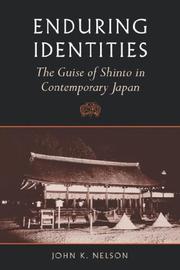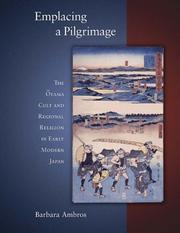| Listing 1 - 4 of 4 |
Sort by
|

ISBN: 0824822595 0824821203 Year: 2000 Publisher: Honolulu University of Hawaii press
Abstract | Keywords | Export | Availability | Bookmark
 Loading...
Loading...Choose an application
- Reference Manager
- EndNote
- RefWorks (Direct export to RefWorks)
J1918 --- J1910.90 --- J1915 --- J1917.80 --- Shinto --- Shinto shrines --- Shinto temples --- Shrines, Shinto --- Temples, Shinto --- Shinto pilgrims and pilgrimages --- Religions --- Japan: Religion -- Shintō -- shrines and pilgrimage --- Japan: Religion -- Shintō -- history -- postwar Shōwa (1945- ), Heisei period (1989- ), contemporary --- Japan: Religion -- Shintō -- rituals and practices --- Japan: Religion -- Shintō -- relations -- society, sociology --- Shinto shrines. --- Shinto. --- Shrines
Book
ISBN: 9781350081192 1350081191 9781474272797 Year: 2018 Publisher: London Bloomsbury Academic
Abstract | Keywords | Export | Availability | Bookmark
 Loading...
Loading...Choose an application
- Reference Manager
- EndNote
- RefWorks (Direct export to RefWorks)
The Ise shrine complex is among Japan's most enduring national symbols, and A Social History of the Ise Shrines: Divine Capital is the first book to trace the history of the shrines from their beginnings in the seventh century until the present day. Ise enshrines the Sun Goddess Amaterasu, the imperial ancestress and the most prominent among kami deities, and has played a vital role in Japan's social, political and religious history. The most popular pilgrims' attraction in the land from the sixteenth century onwards, in 2013 the Ise complex once again captured the nation's attention as it underwent its periodic rebuilding, performed once every twenty years.Mark Teeuwen and John Breen demonstrate that the Ise Shrines underwent drastic re-inventions as a result of on-going contestation between different groups of people in different historical periods. They focus on the agents responsible for these re-inventions, the nature of the economic, political and ideological measures they took, and the specific techniques they deployed to ensure that Ise survived one crisis after another in the course of its long history.This book questions major assumptions about Ise, notably the idea that Ise has always been defined by its imperial connections, and that it has always been a site of Shinto. Written by leading authorities in the field of Shinto studies, this is the essential history of Japan's most significant sacred site.
Religion and sociology --- History --- Ise-Shi (Japan) --- Ise Daijingū --- Kōtai Jingū (Ise-shi, Japan) --- Ise Jingū --- Ise Taibyō --- Grand Shrine (Ise-shi, Japan) --- 伊勢大神宮 --- 伊勢太神宮 --- 伊勢神宮 --- History. --- Ise-shi (Japan) --- Ise, Japan --- Ujiyamada-shi (Japan) --- Religion and society --- Religious sociology --- Society and religion --- Sociology, Religious --- Sociology and religion --- Sociology of religion --- Sociology --- J1918.48 --- J1917.80 --- Japan: Religion -- Shintō -- shrines and pilgrimage -- Kansai and Kinki -- Mie prefecture (Iga, Shima, Ise) --- Japan: Religion -- Shintō -- relations -- society, sociology

ISBN: 9780674027756 0674027752 1684174694 9781684174690 Year: 2008 Publisher: Cambridge Harvard university Asia center
Abstract | Keywords | Export | Availability | Bookmark
 Loading...
Loading...Choose an application
- Reference Manager
- EndNote
- RefWorks (Direct export to RefWorks)
Towering over the Kanto Plain, the sacred mountain Oyama (literally, "Big Mountain") has loomed large over the religious landscape of early modern Japan." "By the Edo period (1600-1868), the revered peak had undergone a transformation from secluded spiritual retreat to popular pilgrimage destination. Its status as a regional landmark among its devotees was boosted by its proximity to the shogunal capital and the wide appeal of its amalgamation of Buddhism, Shinto, mountain asceticism, and folk beliefs. The influence of the Oyama cult - the intersecting beliefs, practices, and infrastructure associated with the sacred site - was not lost on the ruling Tokugawa shogunate, which saw in the pilgrimage an opportunity to reinforce the communal ideals and social structures that the authorities espoused. Barbara Ambros provides a detailed narrative history of the mountain and its place in contemporary society and popular religion by focusing on the development of the Oyama cult and its religious, political, and socioeconomic contexts. Richly illustrated and carefully researched, this study emphasizes the importance of "site" or "region" in considering the multifaceted nature and complex history of religious practice in Tokugawa Japan.
Mountain worship --- J1917.80 --- J1918.13 --- J1940 --- Mountains --- Nature worship --- Japan: Religion -- Shintō -- relations -- society, sociology --- Japan: Religion -- Shintō -- shrines and pilgrimage -- Kantō region -- Kanagawa prefecture (Sagami) --- Japan: Religion -- Shugendō --- Religious aspects --- Ōyama (Kanagawa-ken, Japan) --- Ō Mountain (Kanagawa-ken, Japan) --- Ō-yama (Kanagawa-ken, Japan) --- Religious life and customs. --- 11.87 religions of Japan. --- Mountain worship. --- Wallfahrt. --- Kult. --- Bedevaartplaatsen. --- Cultus. --- Japansk religion --- Geschichte 1500-1900. --- Ōyama (Kanagawa-ken, Japan) --- Japan --- Ōyama
Book
ISBN: 9789004288911 9004288910 9004293787 Year: 2015 Volume: 49 Publisher: Leiden ; Boston : Brill,
Abstract | Keywords | Export | Availability | Bookmark
 Loading...
Loading...Choose an application
- Reference Manager
- EndNote
- RefWorks (Direct export to RefWorks)
Japan's Sexual Gods is an authoritative and original work that describes the unique deities represented by sexual objects in certain Japanese shrines and temples. Hundreds of sexual shrines still exist in spite of previous repression and range from the Tagata Shrine with its well-known giant festival phallus to small obscure places. Many also contain female sexual imagery and some phalluses act in a protective role. The study is based on Observations of over 500 sexual sites including phallic festivals, many of which are modern inventions created purely for commercial reasons. The study makes an assessment of the place of sexual beliefs in modern Japan and includes almost 300 stunning original photographs, a glossary and a highly detailed map.
J1714 --- J1855 --- J1830 --- J1946 --- J1948 --- J1971.80 --- J4172 --- Japan: Religion in general -- sociology of religion --- Japan: Religion -- Buddhism -- rituals and practices -- miscelaneous and superstituous --- Japan: Religion -- Buddhism -- deities --- Japan: Religion -- Shintō -- kami --- Japan: Religion -- Shintō -- rituals, practices, festivals (matsuri) --- Japan: Religion -- Shintō -- relations with society --- Japan: Sociology and anthropology -- family and interpersonal relations -- sex relations (identity, preference, community, customs and culture) --- J1912.90 --- J1915 --- Japan: Religion -- Shintō -- rituals and practices --- J1917.80 --- Japan: Religion -- Shintō -- relations -- society, sociology --- Sex --- Shrines --- Religion. --- Shrines. --- Religious aspects. --- Japan --- Japan. --- Sacred space --- Pilgrims and pilgrimages --- Sex (in religion, folklore, etc.) --- Sex and religion --- Phallicism
| Listing 1 - 4 of 4 |
Sort by
|

 Search
Search Feedback
Feedback About UniCat
About UniCat  Help
Help News
News